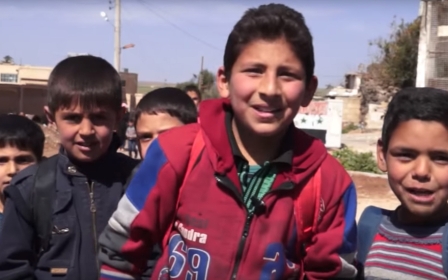Born to war: 3.7m Syrian children know nothing but conflict

One in three Syrian children have known nothing but a lifetime of war, Unicef said on Monday in a report on the eve of the start of its sixth year of war.
The UN's children's agency said that the lives of 3.7 million Syria children had been shaped only by conflict, as thet are forced from their homes and schools, orphaned by violence and drafted into work or fighting.
"Every Syrian child under the age of five has known nothing but a lifetime shaped by war - that's an estimated 2.9 million children inside Syria and at least 811,000 in neighbouring countries," the report said.
Syria's war has killed more than 270,000 people and, according to the United Nations, forced more than half of a pre-conflict population of 23 million from their homes.
"Five years into the war, millions of children have grown up too fast and way ahead of their time," said Peter Salama, Unicef's regional director for the Middle East and North Africa.
"As the war continues, children are fighting an adult war, they are continuing to drop out of school, and many are forced into labour, while girls are marrying early," Salama said.
Inside Syria, "nearly seven million children live in poverty, making their childhood one of loss and deprivation", Salama said.
More than 200,000 children live in areas of Syria under siege, the report said.
And at least 2.1 million children inside the country - and 700,000 in neighbouring countries - are out of school, Unicef said.
A fragile truce since 27 February before indirect peace talks starting on Monday in Geneva has allowed some children to return to their classrooms.
In northern city Aleppo, children have emerged from underground classrooms and gone back to school - and used the playgrounds - for the first time in months.
"Thanks to the ceasefire, we can play and spend time with out friends," said Sidra, one girl. "We can now play on the slides and swings."
In the southern rebel-held Syrian city of Deraa residents have seized upon the ceasefire to return to a sense of normality by attending weddings and also sending their children back to school.
Child soldiers
But, according to the Unicef report, not all Syrian children are so lucky.
"A trend of particular concern is the increase in child recruitment" by armed forces and groups, the report said.
"Children report being actively encouraged to join the war by parties to the conflict offering gifts and "salaries" of up to $400 a month," it said.
Since 2014, recruited children are much younger than in earlier years - some as young as seven - and often without parental consent, it said.
More than half of the Unicef-verified cases of such recruitment last year involved children under 15, compared with less than 20 percent in 2014.
"These children are receiving military training and participating in combat, or taking up life-threatening roles at the battle front," Unicef said.
"Parties to the conflict are using children to kill, including as executioners or snipers."
Girls are being recruited too.
"Huda was just 14 years old when she found herself in her first battle facing armed men, with a weapon she barely knew how to use," the report said.
"I was scared. The commander gave me a gun and said get ready for the battle," Huda, who survived and now lives as a refugee in Jordan, was quoted as saying.
The Islamic State group has released several gruesome videos showing child soldiers killing captives.
New MEE newsletter: Jerusalem Dispatch
Sign up to get the latest insights and analysis on Israel-Palestine, alongside Turkey Unpacked and other MEE newsletters
Middle East Eye delivers independent and unrivalled coverage and analysis of the Middle East, North Africa and beyond. To learn more about republishing this content and the associated fees, please fill out this form. More about MEE can be found here.





